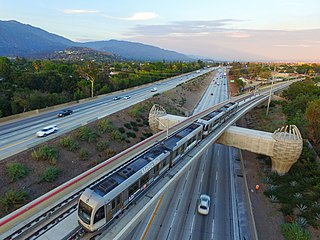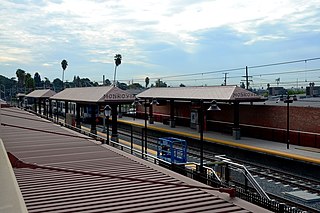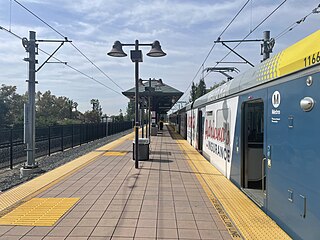
The Los Angeles County Metropolitan Transportation Authority (LACMTA), branded as Metro, is the county agency that plans, operates, and coordinates funding for most of the public transportation system in Los Angeles County, California, the most populated county in the United States, and the largest public transit agency in the county as well.

The Los Angeles Metro Rail is an urban rail transit system serving Los Angeles County, California in the United States. It consists of six lines: four light rail lines and two rapid transit lines, serving a total of 101 stations. It connects with the Metro Busway bus rapid transit system, the Metrolink commuter rail system, as well as several Amtrak lines. Metro Rail is owned and operated by the Los Angeles County Metropolitan Transportation Authority (Metro).

The A Line is a 48.5-mile (78.1 km) light rail line in Los Angeles County, California. It is one of the six lines of the Los Angeles Metro Rail system, operated by the Los Angeles County Metropolitan Transportation Authority (Metro). The A Line serves 44 stations and runs east-west between Azusa and Pasadena, then north-south between Pasadena and Long Beach. It interlines and shares five stations with the E Line in Downtown Los Angeles. Service operates for approximately 19 hours with headways of up to 8 minutes during peak hours. The A Line is currently the longest light rail line in the world.

The L Line and Gold Line are former designations for a section of the current Los Angeles Metro Rail system. These names referred to a single light rail line of 31 miles (50 km) providing service between Azusa and East Los Angeles via the northeastern corner of Downtown Los Angeles, serving several attractions, including Little Tokyo, Union Station, the Southwest Museum, Chinatown, and the shops of Old Pasadena. The line, formerly one of seven in the system, entered service in 2003. The L Line served 26 stations.

The E Line is a 22-mile (35 km) light rail line in Los Angeles County, California. It is one of the six lines of the Los Angeles Metro Rail system, operated by the Los Angeles County Metropolitan Transportation Authority (Metro). The E Line runs east-west and serves 29 stations between East Los Angeles and Santa Monica. It interlines and shares five stations with the A Line in Downtown Los Angeles. Service operates for approximately 19 hours with headways of up to 8 minutes during peak hours. The E Line, the second-busiest light rail line in the system, saw an average of 41,902 passengers on weekdays in October 2023.

The Regional Connector Transit Project constructed a 1.9-mile (3.1 km) light rail tunnel for the Los Angeles Metro Rail system in Downtown Los Angeles. It connected the A and E lines with the former L Line. The A and E lines previously both terminated at 7th Street/Metro Center station, coming from Long Beach and Santa Monica, respectively, while the L Line ran through Little Tokyo/Arts District to either Azusa or East Los Angeles. Now the A and E lines continue together through new stations at Grand Avenue Arts/Bunker Hill, Historic Broadway, and Little Tokyo/Arts District. From there, they diverge on the former L Line toward Azusa and East Los Angeles, respectively. The project provides a one-seat ride into the core of Downtown for passengers on those lines who previously needed to transfer, thus reducing or altogether eliminating many transfers of passengers traveling across the region via Downtown Los Angeles.
The Pasadena Subdivision is the remnant branch line of the former Atchison, Topeka and Santa Fe Railway (AT&SF) Los Angeles Second District. The line currently branches off of Metrolink’s San Bernardino Line at CP Cambridge in Claremont. The line follows a generally east–west alignment, passed through the cities of Claremont, Pomona, La Verne, San Dimas, Glendora, and Azusa before coming to a truncated end in Irwindale. For most of its length, it shares the corridor with the Los Angeles Metro Rail’s A Line. Recent construction, known as the Foothill Extension Phase 2B, has seen the tracks out of service west of San Dimas for most of 2021.

Little Tokyo/Arts District station is an underground light rail station on the Los Angeles Metro Rail system. It replaced an at-grade station with the same name that was located on the east side of Alameda Street between 1st Street and Temple Street, on the edge of Little Tokyo and the Arts District in Downtown Los Angeles. The at-grade station opened in 2009 as part of the Gold Line Eastside Extension and was served by the L Line. The at-grade station closed in October 2020, and the new underground station on the south side of 1st Street between Central Avenue and Alameda Street opened on June 16, 2023.

Arcadia station is an at-grade light rail station on the A Line of the Los Angeles Metro Rail system. It is located at the intersection of 1st Avenue and Santa Clara Street in Arcadia, California, after which the station is named.

Monrovia station is an at-grade light rail station on the A Line of the Los Angeles Metro Rail system. It is located at the intersection of Duarte Road and Myrtle Avenue in Monrovia, California, after which the station is named. This station opened on March 5, 2016, as part of Phase 2A of the Gold Line Foothill Extension Project.

Duarte/City of Hope station is an at-grade light rail station on the A Line of the Los Angeles Metro Rail system. It is located at the intersection of Duarte Road and Highland Avenue in Duarte, California, after which the station is named, along with the City of Hope National Medical Center located across the street from the station.

APU/Citrus College station is an at-grade light rail station on the A Line of the Los Angeles Metro Rail system. It is located between Palm Drive and Citrus Avenue, a block north of Foothill Boulevard, in Azusa, California. It is named after the nearby Azusa Pacific University (APU) and Citrus College.

The Foothill Extension Project, formerly known as the Gold Line Foothill Extension Project, is an extension of the Los Angeles Metro Rail A Line light rail line from the former Gold Line terminus in Pasadena, California, at Sierra Madre Villa station, east through the "Foothill Cities" of Los Angeles County. The plan's first stage, Phase 2A, extended the then-Gold Line from Pasadena to Azusa; it opened on March 5, 2016. Phase 2B, which will extend the now A Line a further four stations to Pomona–North station, broke ground in December 2017. A further two–station extension to Montclair Transcenter is planned for completion in 2028, but is currently unfunded.

Wilshire/La Brea station is an under construction, underground rapid transit station on the D Line of the Los Angeles Metro Rail system at the intersection of Wilshire Boulevard and La Brea Avenue. It is slated to open in 2025. The D Line will serve it and will be the first station on that line west of Wilshire/Western station.

Wilshire/Fairfax station is an under construction, underground rapid transit station on the D Line of the Los Angeles Metro Rail system in LA's Miracle Mile area along Wilshire Boulevard at its intersection with Fairfax Avenue. It is slated to open in 2025. It will be served by the D Line and will be the second station west of Wilshire/Western station.

The Eastside Transit Corridor is a light rail line extension that currently connects Downtown Los Angeles with East Los Angeles. However, the extension is planned to extend further southeast to connect with the Gateway Cities, continuing from a relocated Atlantic station southeast to a new Lambert station in Whittier.
The history of the Los Angeles Metro Rail and Busway system begins in the early 1970s, when the traffic-choked region began planning a rapid transit system. The first dedicated busway opened along I-10 in 1973, and the region's first light rail line, the Blue Line opened in 1990. Today the system includes over 160 miles (260 km) of heavy rail, light rail, and bus rapid transit lines, with multiple new lines under construction as of 2019.

Glendora station is an under construction light rail station in the Los Angeles Metro Rail system. The station is located near the intersection of South Vermont Avenue and Ada Avenue along the Pasadena Subdivision right-of-way in Glendora, California. It will be served by the A Line. It is currently under construction as part of the Foothill Extension Project and is slated to open in early 2025.

San Dimas station is an under construction light rail station in the Los Angeles Metro Rail system. The station is located on San Dimas Avenue near its intersection with Bonita Avenue along the Pasadena Subdivision right-of-way in San Dimas, California. It will be served by the A Line. It is currently under construction as part of the Foothill Extension Project and is slated to open in early 2025.
















